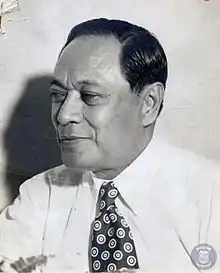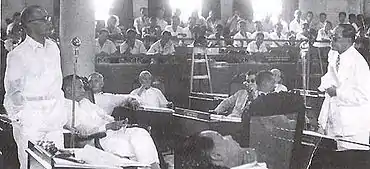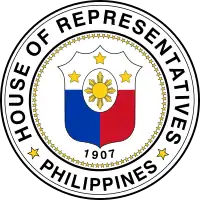Quintín Paredes
Quintín Babila Paredes (born Quintín Paredes y Babila; September 9, 1884 – January 30, 1973) was a Filipino lawyer, politician, and statesman.
Quintin Paredes | |
|---|---|
 | |
| 5th President of the Senate of the Philippines | |
| In office March 5, 1952 – April 17, 1952 | |
| President | Elpidio Quirino |
| Preceded by | Mariano Jesús Cuenco |
| Succeeded by | Camilo Osías |
| 7th Senate President pro tempore of the Philippines | |
| In office January 31, 1950 – March 5, 1952 | |
| President | Elpidio Quirino |
| Preceded by | Melecio Arranz |
| Succeeded by | Manuel Briones |
| Senator of the Philippines | |
| In office December 30, 1949 – December 30, 1961 | |
| Resident Commissioner to the U.S. House of Representatives from the Philippine Islands | |
| In office February 14, 1936 – September 29, 1938 | |
| Preceded by | Francisco Afan Delgado |
| Succeeded by | Joaquín Miguel Elizalde |
| 3rd Speaker of the Philippine House of Representatives | |
| In office 1933 – November 15, 1935 | |
| Preceded by | Manuel Roxas |
| Succeeded by | Gil Montilla |
| Member of the Philippines House of Representatives from Abra's Lone District | |
| In office 1925 – November 15, 1935 | |
| Preceded by | Adolfo Brillantes |
| Succeeded by | Agapito Garduque |
| In office 1938[fn 1] – 1941 | |
| Preceded by | Agapito Garduque |
| Succeeded by | Juan Brillantes |
| In office May 25, 1946 – December 30, 1949 | |
| Preceded by | Jesús Paredes |
| Succeeded by | Virgilio Valera |
| Secretary of Justice | |
| In office July 1, 1920 – December 15, 1921 | |
| Appointed by | Governor-General Francis Burton Harrison Governor-General Leonard Wood |
| Preceded by | Victorino Mapa |
| Succeeded by | José Abad Santos |
| Solicitor-General of the Philippines | |
| In office March 1, 1917 – June 30, 1918 | |
| Preceded by | Rafael Corpus |
| Attorney General of the Philippines | |
| In office July 1, 1918 – June 30, 1920 | |
| Preceded by | Ramon Avanceña |
| Succeeded by | Felecisimo Feria |
| Personal details | |
| Born | Quintín Paredes y Babila September 9, 1884 Bangued, Abra, Captaincy General of the Philippines |
| Died | January 30, 1973 (aged 88) Manila, Philippines |
| Political party | Liberal Party (from 1945) Nacionalista Party (till 1945) |
| Spouse(s) | Victoria Peralta (her death) |
Early life
He was born in Bangued, Abra, Philippines in 1884 to Juan Felix Paredes and Regine Babila.
Education and early career
He obtained his elementary education at the school his father had established, and also studied at the Colegio Seminario de Vigan and at the Colegio de San Juan de Letran. He pursued law at the Escuela de Derecho de Manila. Graduating in 1907, Paredes took and passed the bar examinations the same year, and started his private practice in Manila.
He was appointed fourth prosecuting attorney on July 9, 1908, first prosecuting attorney on November 1, 1913, and served until March 1, 1917.[1]
Government service
He served as Philippine Solicitor General from March 1, 1917 to 1918, as Attorney-General from 1918 to July 1, 1920, and as Secretary of Justice from 1920 to 1921. As Attorney-General, Paredes was a member of the first parliamentary mission to the United States in 1919. He resumed the practice of law in Manila in 1921.
Political career
House of Representatives
He was elected to the Philippine House of Representatives to represent the Lone District of Abra in 1925, 1928, 1931, and 1934, serving as Speaker pro tempore of the House of Representatives from 1929 to 1931,[1] and as the Speaker itself from 1933 till 1935. In 1935 he was elected as a member of the Philippine Assembly but he resigned to serve as the Philippines' Resident Commissioner.[2]

Under the Tydings–McDuffie Act that created the Philippine Commonwealth Government, Paredes became its first Resident Commissioner, serving from February 14, 1936, until his resignation on September 29, 1938.
In 1938 he was again elected a member of the Philippine Assembly, and served as the Majority Floor Leader during this term.[2] He was also elected as a member of the Philippine Senate from 1941 to 1945 that did not sit in session due to the onset of World War II and the Japanese Occupation of the Philippines.
After the Second World War, Paredes ran again for his old post representing Abra in the Philippine House of Representatives, and won. He held this post from 1946 to 1949.
Senate
In the Philippine elections of 1949, Paredes topped the Senatorial race as a candidate of the Liberal Party. He briefly became the President of the Philippine Senate in 1952, and was reelected as a Philippine Senator in 1955, finishing his second term in 1961. Retiring from politics in 1963, Paredes died ten years later in Manila.
Other posts held
See also
Footnotes
- Paredes served under the National Assembly, not under the House of Representatives.
References
- Biographical Directory of the United States Congress: Paredes, Quintin (HTML) Accessed August 9, 2007.
- Official Website of the Senate of the Philippines: Biography of Senate President Paredes Archived October 7, 2007, at the Wayback Machine (HTML) Accessed August 9, 2007.
External links
- Biography of Senate President Paredes at the Philippine Senate Website
- A work translated by Paredes,
- Novena nga Pagdaydayao Quen Aputayo á Jesus Nazareno at Project Gutenberg
- Works by or about Quintín Paredes in libraries (WorldCat catalog)
- United States Congress. "Quintín Paredes (id: P000050)". Biographical Directory of the United States Congress.
![]() This article incorporates public domain material from the Biographical Directory of the United States Congress website http://bioguide.congress.gov.
This article incorporates public domain material from the Biographical Directory of the United States Congress website http://bioguide.congress.gov.
| Political offices | ||
|---|---|---|
| Preceded by Victorino Mapa |
Secretary of Justice 1920–1921 |
Succeeded by José Abad Santos |
| Preceded by Manuel Roxas |
Speaker of the House of Representatives 1933–1935 |
Succeeded by Gil Montilla |
| Preceded by Mariano Jesús Cuenco |
President of the Senate of the Philippines 1952 |
Succeeded by Camilo Osías |
| U.S. House of Representatives | ||
| Preceded by Francisco Afan Delgado |
Resident Commissioner from the Philippines to the United States Congress 1936–1938 |
Succeeded by Joaquín Miguel Elizalde |
| House of Representatives of the Philippines | ||
| Preceded by Adolfo Brillantes |
Representative, Lone District of Abra 1925–1935 |
Succeeded by Agapito Garduque |
| Preceded by Agapito Garduque |
Representative, Lone District of Abra 1938–1941 |
Succeeded by Juan Brillantes |
| Preceded by Jesús Paredes |
Representative, Lone District of Abra 1946–1949 |
Succeeded by Virgilio Valera |

